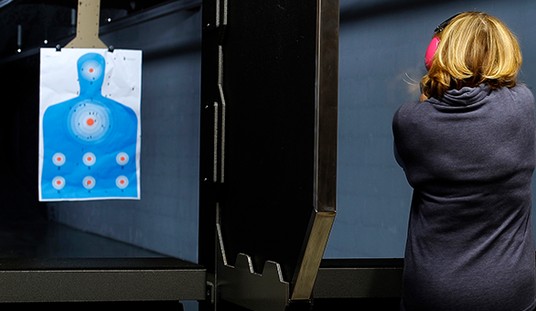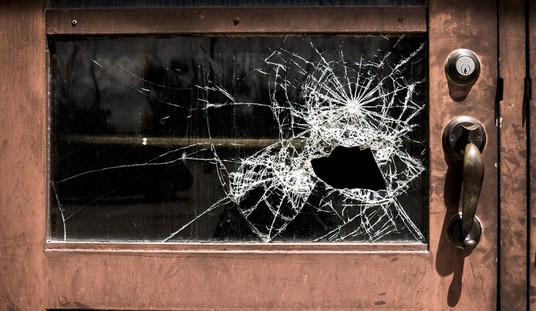 If you’ve never ventured beyond the typical 25-yard pistol range with your carry gun, you may be amazed at how far your gun will shoot. You’ll be even more amazed at how far you can shoot it accurately. Plink five-gallon buckets at 300 yards? Why not? With a little practice you’ll be hitting objects barely large enough to see at distances that require a powerful laser rangefinder to confirm. More often than “Why not?,” the question you’ll likely hear is “Why?” A good answer to that is: Because you can. An even better answer is: Because if you know your gun well enough to hit things way out there, you’ll realize that hitting things a lot closer is a piece of cake.
If you’ve never ventured beyond the typical 25-yard pistol range with your carry gun, you may be amazed at how far your gun will shoot. You’ll be even more amazed at how far you can shoot it accurately. Plink five-gallon buckets at 300 yards? Why not? With a little practice you’ll be hitting objects barely large enough to see at distances that require a powerful laser rangefinder to confirm. More often than “Why not?,” the question you’ll likely hear is “Why?” A good answer to that is: Because you can. An even better answer is: Because if you know your gun well enough to hit things way out there, you’ll realize that hitting things a lot closer is a piece of cake.
LEARNING YOUR GUN’S TRAJECTORY
The best sort of place to develop your long-range skills is against a barren hillside that provides a safe backstop and gives you all-important feedback in the form of dust and dirt splatters so you know where your bullets are hitting. With a target as simple as a distant rock, and other small landmarks to guide you, you can adjust your sight picture accordingly and walk your shots right up to whatever you’re shooting at.
No matter what caliber your pistol, large or small, or the velocity of your projectile, fast or slow, your bullet starts falling toward the ground at the same rate the moment it leaves your muzzle. Since it’s moving forward at the same time it’s falling, it draws a curved line, or an arc, that’s called trajectory. With your sights level, the gun is actually pointed up to some degree so that by the time the bullet arrives at the distance you’ve used as a sighting-in point, the bullet has progressed along its arc sufficiently to drop right into the bull’s-eye. A so-called “flat shooting” bullet doesn’t fall any less or at a slower rate, it simply moves faster and therefore farther along toward the target for every inch it falls. By arriving at the target sooner, a “flat shooting” bullet has simply had less time to fall below the point of aim. If you know your trajectory at any given range, you can hit your target dead-on with any gun, whether “flat shooting” or not, at any distance the bullet is still making forward progress, which is far beyond the distance the target can even be seen.
When you shoot at long range, you can often hear the bullet ripping through the air, and you can sometimes see it dancing through the rays of sunlight as it speeds along its path. It takes a little time for the bullet to arrive at its destination and kick up enough dust for you to see it has landed. It takes even longer for the sound of the bullet’s impact to finally make its way back to your ears. By separating all these various components that are normally compressed into what appears to be a simultaneous and single intense experience in short-range shooting, long-range shooting expands time to give you a more leisurely look at all the things that happen when you pull the trigger. The experience is very much like shooting in slow-motion. For many people, this insight gives them a greater appreciation of the accuracy potential they hold in their hands, and they learn to shoot better at any distance because of it.
BELIEVING ELMER KEITH
Elmer Keith was the most renowned long-range handgunner in the world. He invented the .357, .41 and .44 Magnum revolver cartridges, and was instrumental in the design of the Smith & Wesson revolvers that fired them, including the big Model 29.
At first, many in the firearms establishment doubted Keith’s long-range load development work, his published exploits with his modified revolvers, his 700-yard accuracy, his 600-yard big-game kills, but as undeniable evidence accumulated even his doubters were forced to take Elmer’s accomplishments to heart. This one man, almost entirely on his own, was responsible for the birth of long-range handgunning, a sporting concept that would see vigorous expression on the target ranges and hunting fields of the world.
Made famous by hitting running targets a quarter-mile away, Elmer Keith was known to be a devastating shot at more intimate social ranges as well. Nothing surprising about that.
LONG-RANGE TECHNIQUE
It may come as a surprise to you the first time you hit something with your pistol that most people couldn’t hit with a rifle. It will surely come as a surprise to those around you. The trick, as in all accurate shooting, is to be able to repeat your performance, to do the same thing the same way time after time. Shot-to-shot consistency is the biggest secret to accurate handgun shooting. If you didn’t know this already, a little time spent shooting at long range will drive the lesson home. Consistent hits at long range requires consistency in grip and trigger pull, consistency in sight picture, consistency in the way you handle recoil – “riding the bronc,” as gunwriter and long-range handgun shooter Roger Clouser describes it.
He goes on to say, “The recoil cycle influences accuracy more than any factor because the bullet is still in the barrel while the gun is moving and the shooter controls how the gun moves. Any inconsistency whatsoever on the part of the shooter in any part of the gun movement cycle is an accuracy disaster since the muzzle and departing bullet will be pointed in a different direction. This is true with any caliber handgun, including .22 LR.
“Recoil is not something that should be struggled with, fought or tamed, because that can’t be done consistently either. One takes a ride with recoil in a firm, positive and consistent fashion. A shooter needs to learn the best ballet for his piece and himself. … The ballet must become the shooter’s friend, observed closely and treated identically with every shot.”
In terms of sight picture, rather than aligning your front and rear sights as usual and “holding over” or aiming at some point above your target, it is far more precise to raise the front sight post above level in the rear notch and place that sight picture on your target. Inexperienced long-range shooters tend to overcompensate and shoot high. Be assured that your gun will generally shoot straighter than you think it will.
1,000-YARD REVOLVER SHOOTING
I know some guys who get their kicks with handguns shooting 24-inch steel gongs offhand at 1,000 yards. They use factory revolvers with iron sights they carry around in holsters every day, not short rifles with big scopes set up for such almost-farther-than-the-eye-can-see shooting scenarios. One thing they get out of it is a whole different perspective on handgun accuracy. Clouser says, “On one occasion after the serious 1,000 yard target work was finished, we turned our offhand attention to a 12-inch, 200-yard steel gong on a side hill. It was so big, close and such a lark to hit we grew tired of it in short order.”
Imagine what that kind of experience might do for your accuracy on the 7-yard line.








Join the conversation as a VIP Member